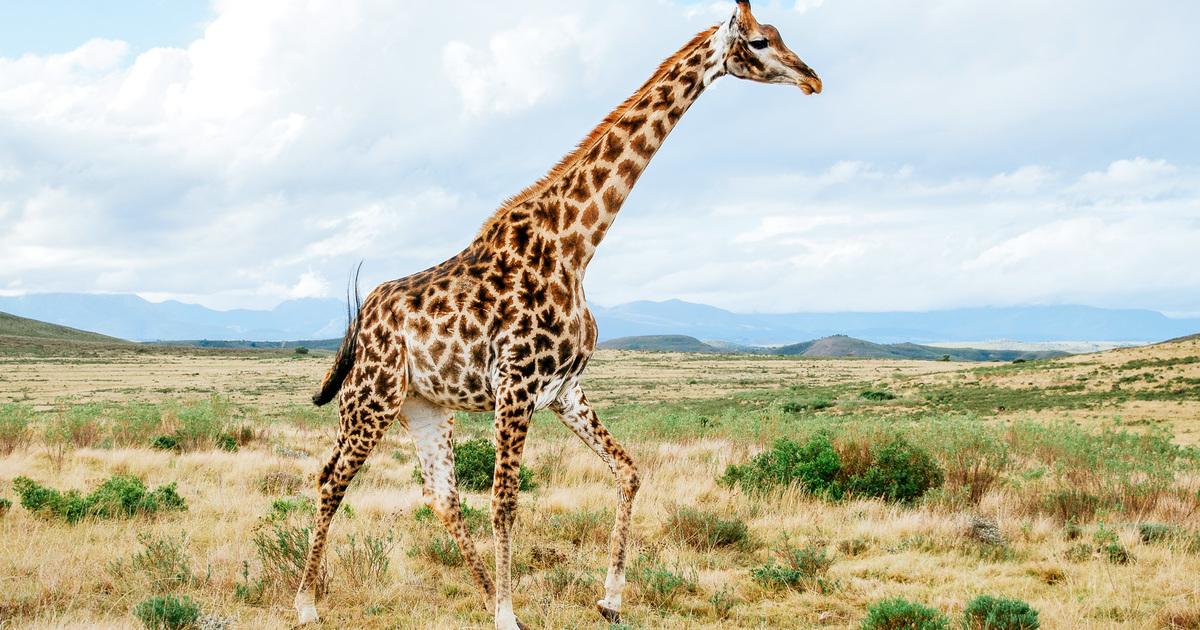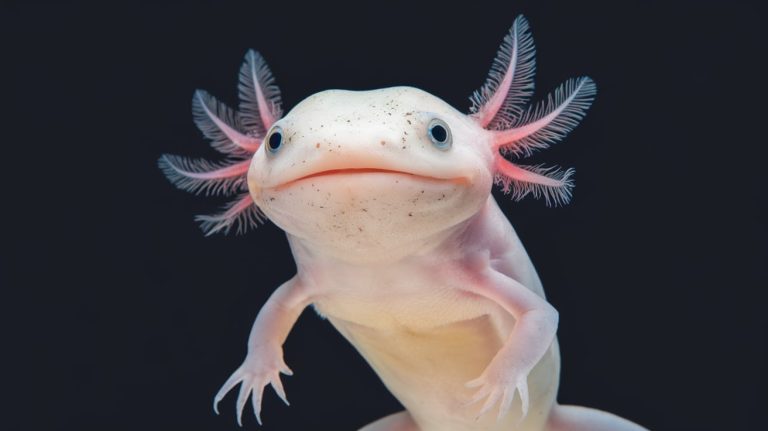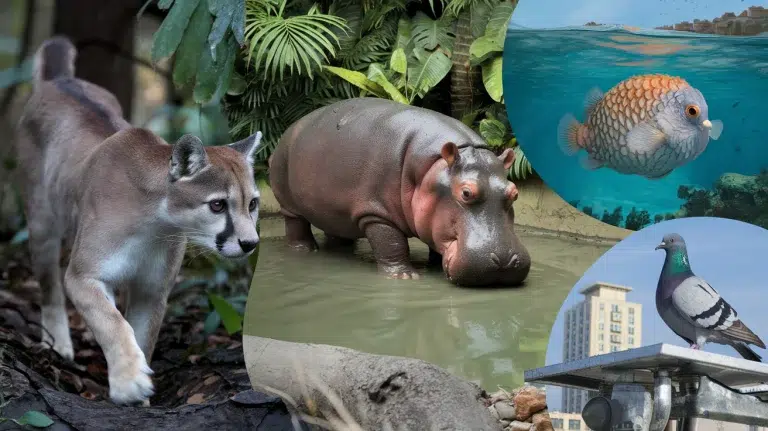22 Fascinating Warm-blooded Animals You Should Know

Have you ever wondered why some animals don’t shiver in the cold? Warm-blooded creatures are the answer. Many of us know about cats and dogs, but there’s a whole world of 22 interesting warm-blooded animals.
It’s easy to feel lost when trying to learn about wildlife. There are so many species, and it can be hard to know where to start. But don’t worry, I’ve got you covered.
Did you know that some warm-blooded animals can fly while others live underwater? From furry mammals to feathered friends, this list will open your eyes to the world of warm-blooded wonders.
Ready to meet some of nature’s most interesting heat-makers? Let’s jump in and explore these warm-blooded marvels together!
List of Warm-blooded Animals to Explore
1. Bats

Bats originated over 50 million years ago and are found everywhere except Antarctica. These small, nocturnal mammals have leathery wings and varying body sizes, with a generally sleek and dark appearance.
The scientific name for bats varies across species, with the common little brown bat being Myotis lucifugus. Their lifespan ranges from 10 to 20 years.
- Habitat: Caves, forests, and urban areas.
- Diet: Insects, fruits, nectar, and small animals.
- Why They’re Called Warm-Blooded: Bats maintain a constant body temperature, allowing them to fly and hunt at night.
2. Blue Whales

Blue whales, the largest animals on Earth, originated in the world’s oceans millions of years ago. They have a sleek, blue-gray body that can grow up to 100 feet long.
The scientific name for the blue whale is Balaenoptera musculus, and they have a lifespan of 70 to 90 years.
- Habitat: Open oceans worldwide.
- Diet: Krill and small marine organisms.
- Why They’re Called Warm-Blooded: Blue whales can regulate their body temperature, which is crucial for survival in cold ocean waters.
3. Elephants

Elephants, native to Africa and Asia, are known for their massive size, thick gray skin, and long trunks. The African elephant’s scientific name is Loxodonta africana, while the Asian elephant is called Elephas maximus.
They typically live for 60 to 70 years.
- Habitat: Savannas, forests, and grasslands.
- Diet: Grasses, fruits, and bark.
- Why They’re Called Warm-Blooded: Elephants maintain a stable internal temperature despite external conditions.
4. Kangaroos

Kangaroos are marsupials native to Australia characterized by strong hind legs and large, muscular tails. Their short fur varies in color from reddish to gray.
The scientific name for the red kangaroo is Macropus rufus, and their lifespan ranges from 12 to 18 years.
- Habitat: Grasslands, savannas, and woodlands.
- Diet: Grasses, leaves, and shrubs.
- Why They’re Called Warm-Blooded: Kangaroos regulate their body temperature, which is vital for surviving the hot Australian climate.
5. Dolphins

Dolphins, found in oceans worldwide, are sleek, aquatic mammals with smooth, gray skin and a streamlined body. The common bottlenose dolphin’s scientific name is Tursiops truncatus, and they can live for 40 to 60 years.
- Habitat: Coastal and open ocean waters.
- Diet: Fish, squid, and crustaceans.
- Why They’re Called Warm-Blooded: Dolphins maintain a constant internal temperature, which helps them survive in varying ocean temperatures.
6. Lions

Lions are large, powerful cats native to Africa, known for their golden fur and majestic manes in males.
The scientific name for the lion is Panthera leo, and their lifespan in the wild is about 10 to 14 years.
- Habitat: Grasslands, savannas, and open woodlands.
- Diet: Large herbivores like zebras, antelopes, and wildebeests.
- Why They’re Called Warm-Blooded: Lions regulate their body temperature to maintain optimal function during hunts.
7. Polar Bears

Polar bears, native to the Arctic Circle, are large, white-furred carnivores perfectly adapted to cold environments.
Their scientific name is Ursus maritimus, and they live for about 20 to 30 years in the wild.
- Habitat: Arctic sea ice, coastal regions, and tundras.
- Diet: Seals, fish, and marine mammals.
- Why They’re Called Warm-Blooded: Polar bears regulate their body temperature to survive extreme colds.
8. Giraffes

Giraffes are native to Africa and are known for their incredibly long necks, spotted coats, and towering height. The scientific name for the giraffe is Giraffa camelopardalis, and they live for 25 to 30 years in the wild.
- Habitat: Savannas, grasslands, and open woodlands.
- Diet: Leaves, particularly from acacia trees.
- Why They’re Called Warm-Blooded: Giraffes maintain a stable internal temperature despite the often hot climates they inhabit.
9. Wolves

Wolves are native to the Northern Hemisphere. They have a robust build, thick fur, and a bushy tail.
The scientific name for the gray wolf is Canis lupus, and they live for about 6 to 8 years in the wild.
- Habitat: Forests, tundras, and grasslands.
- Diet: Large ungulates like deer and elk, as well as smaller animals.
- Why They’re Called Warm-Blooded: Wolves maintain a constant body temperature, which aids in endurance during hunts.
10. Penguins

Penguins are flightless birds native to the Southern Hemisphere, known for their black-and-white plumage and upright posture. The emperor penguin’s scientific name is Aptenodytes forsteri, and they live for about 15 to 20 years.
- Habitat: Antarctic ice and sub-Antarctic islands.
- Diet: Fish, krill, and squid.
- Why They’re Called Warm-Blooded: Penguins can maintain their body temperature even in freezing environments.
11. Ostriches

Ostriches are large, flightless birds native to Africa. They are known for their long necks, powerful legs, and impressive running speed.
The scientific name for the ostrich is Struthio camelus, and they can live for 40 to 50 years.
- Habitat: Savannas, deserts, and open woodlands.
- Diet: Plants, seeds, and small insects.
- Why They’re Called Warm-Blooded: Ostriches maintain a constant internal temperature, allowing them to thrive in varying climates.
12. Hummingbirds

Hummingbirds are small, vibrant birds found in the Americas, recognized for their iridescent feathers and rapid wing beats.
The scientific name for the ruby-throated hummingbird is Archilochus colubris; they live for 3 to 5 years.
- Habitat: Forests, gardens, and meadows.
- Diet: Nectar, small insects, and spiders.
- Why They’re Called Warm-Blooded: Hummingbirds maintain a high metabolism and body temperature, which is crucial for their energetic flight.
13. Owls

Owls are nocturnal birds of prey found worldwide. They are known for their round faces, large eyes, and silent flight.
The scientific name for the barn owl is Tyto alba, and they can live for 4 to 10 years in the wild.
- Habitat: Forests, grasslands, and urban areas.
- Diet: Small mammals, birds, and insects.
- Why They’re Called Warm-Blooded: Owls regulate their body temperature, enabling them to hunt efficiently at night.
14. Albatrosses

Albatrosses are large seabirds found primarily in the Southern Hemisphere. They are recognized for their long wingspans and impressive gliding ability.
The scientific name for the wandering albatross is Diomedea exulans, and they can live for over 50 years.
- Habitat: Open oceans and remote islands.
- Diet: Fish, squid, and krill.
- Why They’re Called Warm-Blooded: Albatrosses maintain a stable internal temperature, vital during long flights over cold ocean waters.
15. Peacocks

Peacocks, native to South Asia, are famous for their vibrant, iridescent plumage and elaborate tail displays. The scientific name for the Indian peafowl is Pavo cristatus, and they can live for 15 to 20 years.
- Habitat: Forests, farmlands, and gardens.
- Diet: Grains, insects, and small reptiles.
- Why They’re Called Warm-Blooded: Peacocks maintain a constant body temperature, which helps them thrive in various environments.
16. Falcons

Falcons are birds of prey found worldwide. They are known for their speed and keen hunting abilities.
The scientific name for the peregrine falcon is Falco peregrinus; they live for 13 to 20 years.
- Habitat: Mountains, coastlines, and urban areas.
- Diet: Small birds, mammals, and insects.
- Why They’re Called Warm-Blooded: Falcons maintain a high metabolism and body temperature, essential for their powerful flight and hunting.
17. Tigers

Tigers, native to Asia, are large, solitary cats with distinctive orange coats and black stripes.
The scientific name for the Bengal tiger is Panthera tigris tigris, and they live for 10 to 15 years in the wild.
- Habitat: Forests, grasslands, and swamps.
- Diet: Large herbivores like deer and wild boar.
- Why They’re Called Warm-Blooded: Tigers regulate their body temperature, which helps them hunt effectively in various climates.
18. Gorillas

Gorillas, native to Africa, are large primates known for their muscular build, dark fur, and close genetic relationship to humans.
The scientific name for the western gorilla is Gorilla gorilla, and they live for 35 to 40 years.
- Habitat: Tropical forests and lowland swamps.
- Diet: Fruits, leaves, and shoots.
- Why They’re Called Warm-Blooded: Gorillas maintain a constant internal temperature, which is vital for their large size and complex social behaviors.
19. Rabbits

Rabbits are small, herbivorous mammals found worldwide. They are recognized for their long ears, soft fur, and rapid reproduction. The scientific name for the European rabbit is Oryctolagus cuniculus, and they live for 9 to 12 years.
- Habitat: Meadows, forests, and grasslands.
- Diet: Grasses, vegetables, and bark.
- Why They’re Called Warm-Blooded: Rabbits regulate their body temperature, which helps them remain active and reproduce quickly in various environments.
20. Flamingos

Flamingos are wading birds native to parts of Africa, South America, and the Caribbean. They are known for their striking pink color and long legs.
The scientific name for the greater flamingo is Phoenicopterus roseus, and they can live for 20 to 30 years.
- Habitat: Shallow lakes, lagoons, and mangrove swamps.
- Diet: Algae, small crustaceans, and plankton.
- Why They’re Called Warm-Blooded: Flamingos maintain a stable body temperature, which supports their long migrations and social behaviors.
21. Rhesus Monkeys

Rhesus monkeys, native to South, Central, and Southeast Asia, have brownish fur and a lighter face and are highly adaptable primates.
The scientific name for the rhesus monkey is Macaca mulatta, and they can live for around 25 years.
- Habitat: Forests, grasslands, and urban areas.
- Diet: Fruits, seeds, roots, and insects.
- Why They’re Called Warm-Blooded: Rhesus monkeys maintain a constant internal temperature, which is crucial for their active and social lifestyle.
22. Cheetahs

Cheetahs, native to Africa and parts of Iran, are known for their incredible speed and slender, spotted bodies.
The scientific name for the cheetah is Acinonyx jubatus, and they typically live for 10 to 12 years in the wild.
- Habitat: Grasslands, savannas, and open plains.
- Diet: Medium-sized ungulates like gazelles and impalas.
- Why They’re Called Warm-Blooded: Cheetahs regulate their body temperature to maintain the high energy required for short bursts of speed during hunts.
Conclusion
We’ve taken a trip through the world of warm-blooded animals, from cuddly mammals to surprising sea creatures. These animals have some cool tricks to keep their body heat just right.
Why does this matter? Understanding warm-blooded animals helps us see how different creatures adapt to their homes. It shows us how connected we are to nature and how much we still have to learn about the world around us.
What’s next? I hope this list has sparked your interest in these amazing animals. Why not pick your favorite from the list and do some more digging?
Or better yet, see if you can spot any warm-blooded wonders in your local area. Remember, there’s always more to learn about our animal friends.
Keep Exploring!






